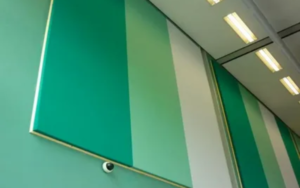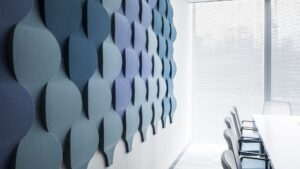
Introduction:
Ceiling baffles are a practical way to reduce noise and enhance acoustics in a variety of settings. However, for best
effects, choosing the appropriate material for your ceiling baffles is essential. This blog will examine the
significance of picking the right material and look into the many things to take into account when choosing ceiling
baffle materials.
Acoustic Performance:
By absorbing sound waves and decreasing reverberation, ceiling baffles improve acoustic performance. The ability
of different materials to absorb sound varies, directly affecting how well the baffles work. Because of their
excellent sound-absorbing qualities, materials like mineral wool and fibreglass are frequently used for ceiling
baffles. These materials are able to absorb a substantial quantity of sound energy because of their high Noise
Reduction Coefficient (NRC) ratings. Consider the particular acoustic needs of your room when choosing the
material for your ceiling baffles, and select a material with a high NRC value for the best noise suppression.

Aesthetics and Design:
Apart from their functional role, ceiling baffles also contribute to the aesthetic appeal of the space. The material
chosen for the baffles should align with the overall design scheme and ambiance of the room. Various materials
offer different visual characteristics, textures, and finishes that can complement or enhance the interior design.
For instance, fabric-covered baffles can provide a softer and more visually appealing look, while metal baffles offer
a sleek and modern appearance. Consider the desired visual impact and choose a material that aligns with your
aesthetic preferences and the design goals of the space.
Maintenance and lifetime:
The material selected affects the ceiling baffle’s lifetime and maintenance needs. Essential concerns include things like resistance to moisture, fire resistance, and dust or dirt collection. Materials that prevent the growth of mould or mildew are essential for locations with high humidity or moisture. Fire-rated materials can also increase safety in commercial or public settings. As some materials may need routine cleaning or maintenance to preserve their function and look, ease of maintenance should also be taken into account.
Environmental Considerations:
In today’s environmentally conscious world, selecting sustainable and eco-friendly materials is becoming
increasingly important. When choosing ceiling baffle materials, consider their environmental impact and look for
options made from recycled or renewable materials. Materials with low volatile organic compound (VOC)
emissions are preferable to maintain good indoor air quality. Additionally, selecting materials with a long lifespan
reduces the need for frequent replacements, minimizing waste and resource consumption.
Cost and Budget:
Budget is an important consideration when selecting ceiling baffle materials. Different materials vary in cost, and
it’s essential to find a balance between the desired acoustic performance, aesthetics, and affordability. Consider
the long-term value and durability of the material to ensure you make a cost-effective choice that meets your
requirements.
Conclusion:
Choosing the right material for your ceiling baffles is vital for achieving optimal acoustic performance, visual
appeal, durability, and environmental sustainability. Consider the specific acoustic needs, aesthetic goals,
maintenance requirements, environmental impact, and budget constraints to make an informed decision. By
selecting the appropriate material, you can transform your space into a harmonious and aesthetically pleasing
environment with enhanced acoustic qualities.



